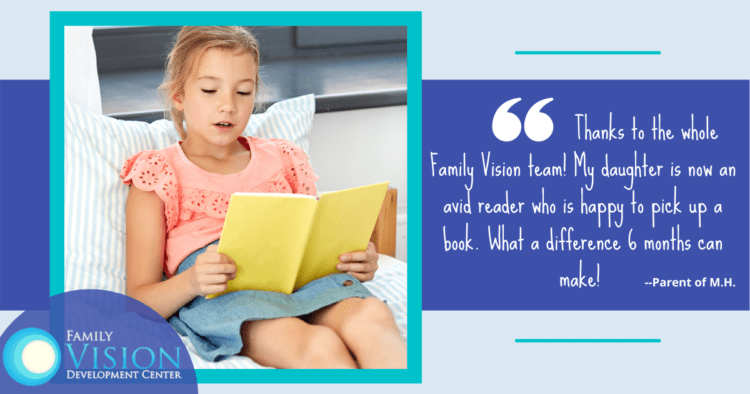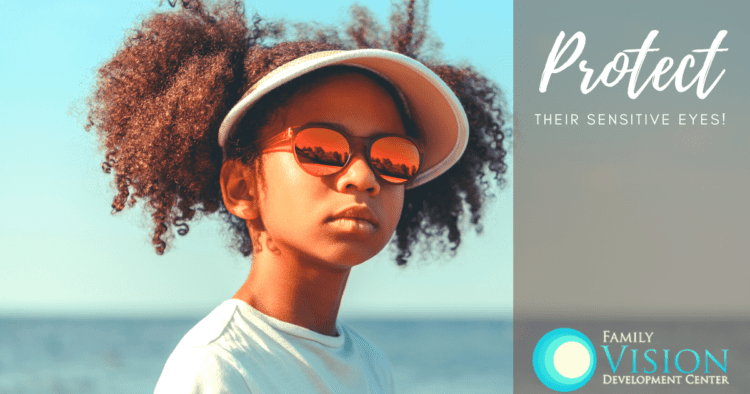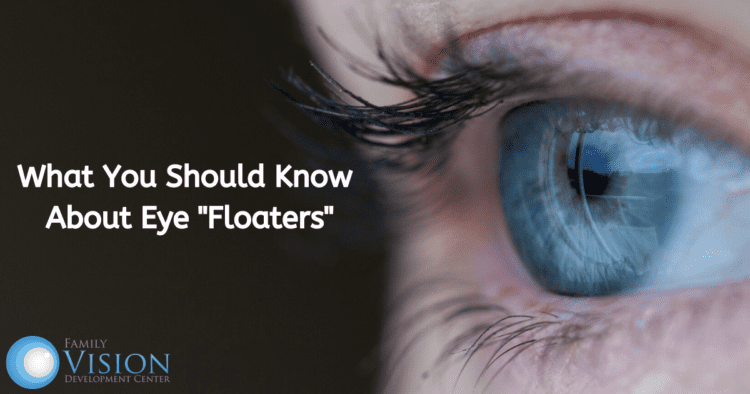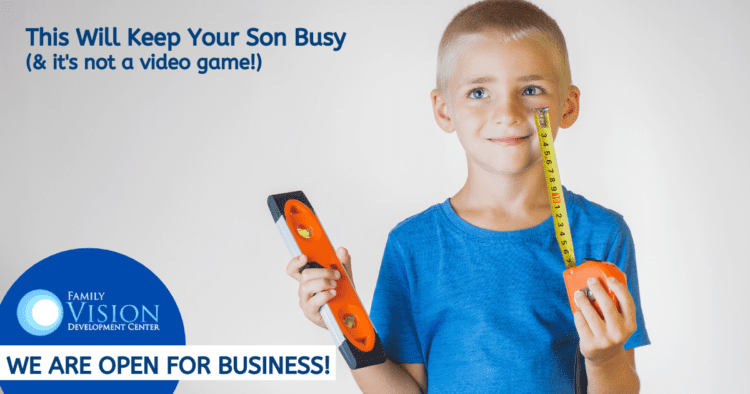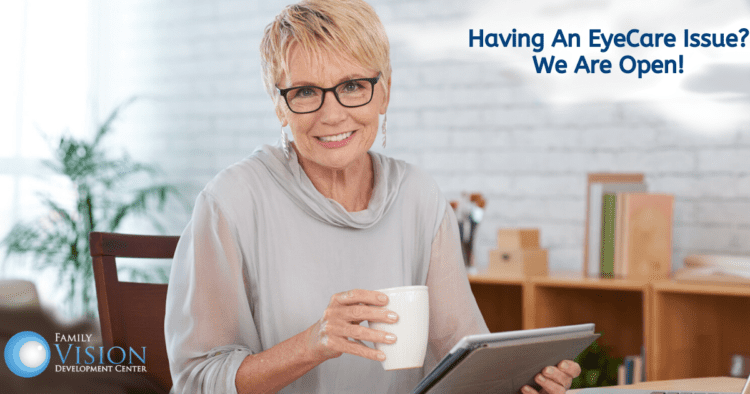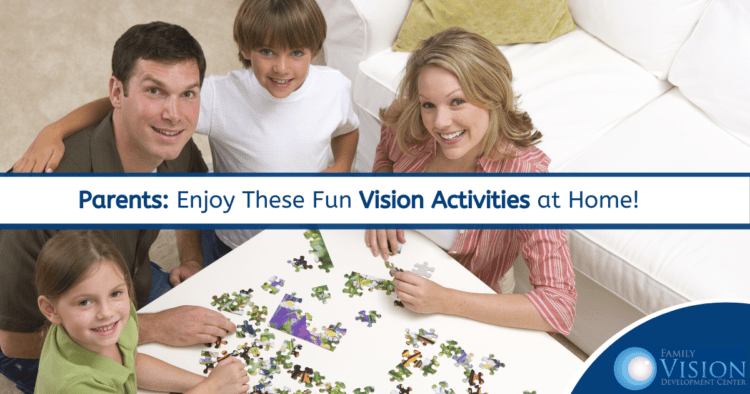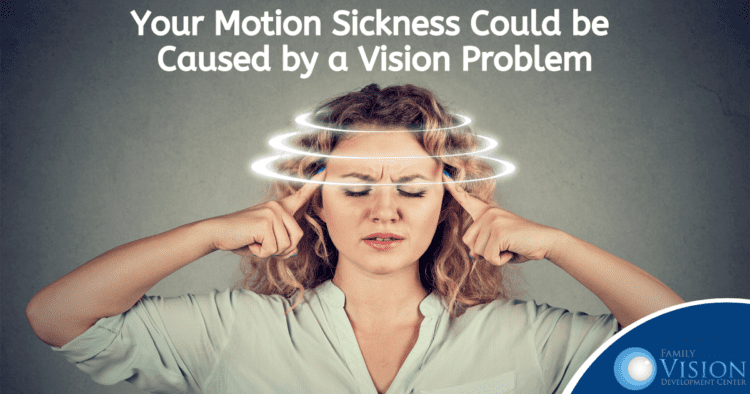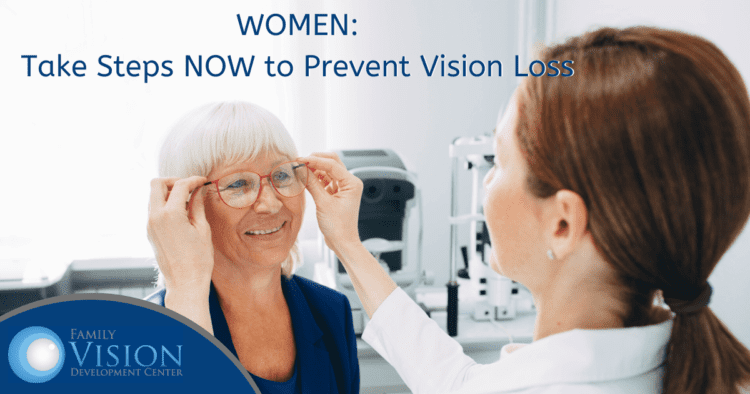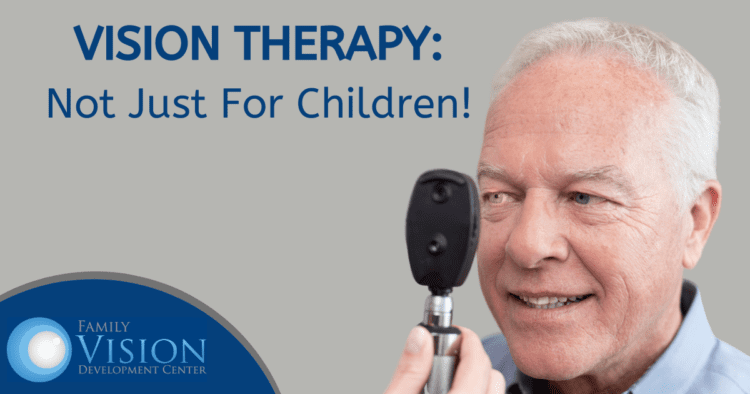Encouraging your child to read is an important way to improve their overall language skills. Likewise, strong reading skills can help a child succeed in school, as well as build an overall sense of self-esteem. When a child gradually, or suddenly, seems to lose interest in reading, it is wise to look for a vision disorder as a possible cause.
The following vision issues can affect a child’s reading ability. Fortunately, our vision therapy programs can greatly improve, or even eliminate, the symptoms of these conditions.
How Amblyopia Affects Reading
Amblyopia is a common vision condition in children. This disorder occurs when the eyes and brain do not work together properly. As a result, the brain will choose to use only one eye as its primary source of visual information. The other eye will “shut off” and will not be used very often, or at all. Sometimes this will cause the eye to drift in or out, but many times it remains perfectly straight. Other symptoms may include double vision, nearsightedness or farsightedness in one eye, or poor depth perception. All of these, of course, can cause a child’s reading skills to suffer.
Effects of Convergence Insufficiency
Reading can be extremely difficult for a child with convergence insufficiency. This condition is characterized by the inability to move and focus both eyes inward on close objects. Obviously, this would affect an activity like reading. In addition, a child with this disorder can experience eye strain, headaches, dizziness and difficulty concentrating. Vision therapy can help treat convergence insufficiency, thereby allowing a child’s reading skills to flourish.
Visual Processing Disorders Also Affect Reading Skills
When a child suffers from a visual processing disorder, their brain has trouble processing the information it receives. This condition does not affect actual clarity of vision, but rather the brain’s ability to make sense of what the eyes are seeing. For example, letters like b and d might get mixed up. Or when reading, they may read the same line several times, or skip lines completely.
Vision disorders, like those described above, can often go undetected in a standard vision screening. Unfortunately, school-provided screenings are the only vision tests many kids receive at a young age. As such, reading skills can continue to suffer throughout a child’s school years. Our comprehensive vision exam is the best way to detect a wide range of vision disorders. It is also important to note that the earlier an issue is diagnosed the better the chance of a successful treatment. Our vision therapy programs are highly effective at any age. But it is always better to start as soon as possible. Contact our office at 630-862-2020 for more information or to schedule your appointment.
Additional information can be referenced here and here.
The sunny days of summer are finally here to stay, at least for a while. And that means more time outdoors and more opportunity for your eyes to get damaged by the sun’s harmful rays. You apply sunscreen to protect your skin, but don’t forget to put on a good pair of sunglasses to ensure your eyes are also protected. Polarized sunglasses are a good choice for many. Read on to see if they might be right for you.
What are polarized sunglasses
The main purpose of polarized sunglasses is to get rid of glare. Polarized lenses contain a special filter that blocks certain types of light, thereby reducing or eliminating that blinding glare often seen when bright sunlight reflects off a surface.
Why polarized sunglasses can be a good choice
There are a number of situations in which reducing glare is important, and polarized sunglasses might come in handy. For instance, drivers can often operate their vehicle more effectively when glare is reduced from the road or even other cars. Likewise, boaters and skiers often wear this type of eyewear to better navigate the water or snow-covered hills.
In addition to glare reduction, polarized sunglasses can allow for a truer perception of colors, improve contrast and clarity, and reduce overall eye strain.
There are some drawbacks
While polarized lenses help eliminate glare, they also reduce your ability to see LCD displays. This means that it can be very difficult to properly view screens at an ATM or gas pump, or your car’s instrument panel on the dashboard. Likewise, some people have trouble viewing their phone’s screen when wearing polarized sunglasses. Additionally, pilots should definitely not wear them, as they can interfere with proper viewing of their instrument panel.
Polarized sunglasses can range in style, price and actual UV protection. A high price tag does not always mean you will be getting the best quality. In fact, there are some very affordable options that do a really great job. Visit Family Vision Development Center in Aurora to view our full selection, including great brands like Maui Jim and Nike. Of course, give us a call first at 630-862-2020 to confirm our hours and availability to help you select the perfect pair!
Additional information can be referenced here
What are floaters? Have you noticed little spots or string-like shapes in your vision that tend to move around when you try to focus on them? Perhaps they are more pronounced when you look at something bright, like the sky? If so, you could be experiencing a vision issue known as eye “floaters.” While floaters can be an annoying distraction, they often simply pop up as part of the normal aging process. Some, however, can be a sign of a serious eye condition. If you discover one in your field of vision, you should see your eye doctor right away to rule out any vision-threatening issues.
What Are Floaters?
They get their name from the fact that they seem to move and drift around the eye. When you try to focus on one, you may find it shifts away. The “floater” itself is actually vitreous, a gelatinous-like substance in the eye. Over time, the vitreous can thin out, shrink, and break away from the retina into stringy fragments. These fragments explain why floaters appear as various shapes. Common floaters look like strings, dots, spots, rings and even cobwebs.
Are Floaters a Serious Problem?
Many people develop them as a part of the natural aging process. In addition, they can appear due to stress or injury. However, in some instances, they may be a symptom of much more serious eye conditions such as retinal detachment or hemorrhaging. Be sure to visit your eye doctor right away if you notice a sudden increase in the number of floaters you have, if you start to see flashes of light, or if you notice dark areas in your peripheral vision.
Are Floaters Permanent?
Depending on the root cause, many will get smaller and eventually go away on their own or at least settle out of the field of vision. This can take anywhere from a few weeks to a few months. In cases where it does not disappear, people often adapt to “seeing” the floater and it no longer poses a serious problem. In extreme cases, where vision is impaired, surgical options are available.
The first step in evaluating your floaters is to make an appointment with Family Vision Development Center in Aurora. Our highly-trained staff will perform a thorough eye exam and take time to answer any questions you may have about your eye issues. Call us at 630-862-2020 to schedule an appointment or use our convenient online appointment request form.
Additional information here, here, here and here
Wasn’t it so nice when the kids were little and you could hand them some craft paint and an empty tissue box and they would amuse themselves for hours. PreTeens are a much harder group to please!
Of course, you could hand your kid their iPad and let them spend the day shooting things or popping bubbles or whatever other app they may have loaded. And, realistically, this is an easy way out if you want to entertain your 12yr old for the afternoon.
How about some other great ideas that will grow their brain and exercise their eyes? Here are 2 great craft activities that will engage your 11yr old for hours:
Project 1: Yardstick Launcher Craft
Hurl lightweight balls, toys, and other objects toward a target across the room with the stomp of a foot. By Rachelle Doorley, TinkerLab
WHAT YOU’LL NEED FOR THIS CRAFT:
– Clean metal can (like a coffee can)
– Scrapbook(thick) paper
– Tape
– Yardstick
– Acrylic paint and paintbrush
– Hot glue
– 4 plastic cups
– Rubber band
– Ping-pong balls or other small objects
WHAT TO DO
- Cover the can with scrapbook paper and secure with tape. Paint the yardstick; let dry.
- Use hot glue to attach the plastic party cups to one end of the yardstick (an adult’s job). Secure the can to the middle of the yardstick with a rubber band.
- Place ping-pong balls or other small objects in the cups, then stomp or press down firmly on the free end of the yardstick to launch the projectiles across the room.
HOW DOES IT WORK?
A lever is a simple machine made from a rigid beam (the yardstick) and a fulcrum (the can). When your child applies downward force to one side, it elicits an opposite reaction, sending the unattached load (the ping-pong balls) flying. You can change the amount of effort it takes to move those balls: The closer the can is to the cups, the less work it takes to move the projectiles.
Psst! Like this craft activity? Check out Doorley’s book TinkerLab: A Hands-on Guide for Little Inventors.
While your child was making this project, did you notice them getting very close to the objects while they were painting? This could be a sign of vision issues – give Family Vision Development Center a call at 630-862-2020 to ask any questions you may have
Project 2: How To Make A No Sew T-Shirt Tote Bag Craft
Supplies:
- Old t-shirt – The thicker the fabric, the sturdier the bag
- Sharp scissors, preferably fabric scissors
- Washable marker (optional)
Directions for this craft:
Step 1: Cut the sleeves off
Step 2: Cut the neckline area
Trace the bowl and then cut along the line
Step 3: Determine how deep you want the bag to be
Turn the shirt inside out and trace a line across where you want the bottom of the bag to be. Keep in mind that depending on the fabric used, your tote is likely stretch and become longer when it’s filled with stuff.
Step 4: Cut fringe
Now grab your scissors and cut slits from the bottom of the shirt up to the line marking the bottom of your bag. You’ll want to cut both the front and back layers together because they need to match up for the next step.
Step 5: Tie Fringe
Okay, this is going to sound really complicated, but it’s NOT, promise. Take your first pair of fringe and tie it into a knot, then tie two more pairs. Now if you lift your bag, you’ll see that although the pairs are pulling the bag together, there’s a hole between each pair. This next step will close those holes.
In the photo above you see three sets of fringe that have been tied in knots. What I do next is grab one strand from the middle set (the one with the arrow pointing left) and tie it in a knot with one of the strands on the left set. Then I take the other strand from the middle set (the one with the arrow pointing right) and tie it in a knot with one of the strands on the right set.
Then I take the remaining strand on the right set and tie it to the next set of strands, and so on and so forth until all the strands are tied. Now turn your t-shirt right side out again and voila, your craft is done!
We hope your kids enjoy these projects!
When was the last time your child had an eye exam? Great vision is important your whole life! If you’d like to schedule an appointment with one of our kid-friendly eye doctors at Family Vision Development Center, give us a call at 630-862-2020.
Sources here and here
Dr. Martin and his staff are providing essential services for those who have eyecare needs/ vision issues during this COVID-19 restricted time. We understand that, while things like regular checkups may not be urgent, vision issues or immediate problems are not to be put off and can require an appointment.
OFFICE CLEANLINESS
We want you to know that we are cleaning the office and adhering to healthcare recommendations in order to keep you and your family safe while you visit our office. Our appointment times are changing often so please call us directly if you have a concern or question. We can then check for opening on our revised calendar so we can schedule you a visit during our open hours.
URGENT VISION ISSUES
If you are experiencing vision issues such a double-vision, “floaters,” blurry vision, or new headaches, these are issues that should not be put off to a later date. Please call us and we can advise you if you need to be seen by one of our doctors. Oftentimes, the sooner a condition is treated, the better results the patient will see.
CHILDREN’S VISION ISSUES
Also, for those of you that have children at home, now that you are watching them go thru their daily school work, you may notice some habits which could indicate they are having vision issues. If you see any of the following, please let us know:
- Leaning in very close to a paper they are reading
- Complaints of headaches towards the end of the day
- Excessive blinking while they are reading
- They are covering one eye while reading
- They focus for only a very short time and then walk away or stop reading often
These could all indicate vision issues. Please contact our office to let us know what signs they are exhibiting so we can further advise you as to the what the problem may be.
Everyone here at Family Vision Development Center hopes that you take the time to enjoy this extra time with family, take the time to slow down a bit, and that you stay healthy & safe! Please contact us at 630-862-2020 to ask any questions you may have or to schedule an urgent appointment.
Source here
If your child suffers from vision issues, you know just how much of an impact this can have on their school performance. Visual processing skills are critical to a child’s success, and vision therapy is an effective way to treat many eye conditions. Family Vision Development Center vision therapy programs are customized for each patient, and include in-office evaluation and treatment along with at-home exercises. While most vision therapy exercises are technical and designed to treat specific eye disorders, there are some general activities that can be done at home that will allow you to include ALL family members in the fun.
Here are some hands-on activities you can do at home with your children to help develop their visual processing skills. Please note: these activities are not meant to replace a professional vision therapy program. You should talk to your doctor before starting any vision therapy exercises to ensure you are completing the correct activities for your diagnosis.
Activity #1: Puzzles and Mazes
Puzzles are a fun, family activity that can help your child with visual perception or visual thinking. Be sure not to choose a puzzle that’s so hard your child becomes frustrated. Mazes are also a great tool to build visual tracking skills. Have your child complete the maze with a pencil and again with their finger.
Activity #2: Drawing and Coloring
Coloring and drawing are easy ways for children to work on hand-eye coordination and attention to detail. Many children with eye disorders can benefit from coloring. For example, children with Amblyopia who are being treated with an eye patch can strengthen the “lazy eye” by coloring and drawing while wearing their patch.
Activity #3: Board Games
Board games can not only help you limit your child’s screen time, but many of them can help develop visual processing skills as well. While there is a wealth of modern educational board games available, some of the “old fashioned” games like Connect 4, Operation and Pick-Up-Sticks can be just as beneficial and fun.
At Family Vision Development Center, vision therapy is our specialty and we are passionate about helping your child. If you think your child may have vision issues, contact us right away to see how vision therapy can help. We will customize a program to meet your child’s individual needs. Visit us online or call 630-862-2020 to schedule an appointment. Serving Aurora, Woodridge, & others.
Additional information referenced here, here, here and here
Motion sickness is an unpleasant condition that can affect both adults and children. From traveling, to reading in the car, to watching movies or playing video games, often times motion sickness is triggered at the most inopportune times. For some people who suffer from motion sickness symptoms, an underlying vision issue may be to blame.
Neuro-Ocular Vestibular Dysfunction (See-Sick Syndrome)
Neuro-Ocular Vestibular Dysfunction (NOVD), also known as “See-Sick Syndrome (SSS)” occurs when our vision and balance (vestibular) systems in our body do not communicate correctly. See-Sick Syndrome causes a person to be super sensitive to light, as well as experience motion sickness with visual motion and eye movement.
Symptoms
See-Sick Syndrome causes many symptoms that can affect a person’s ability to perform everyday tasks like driving and reading. Some patients have reported being unable to shop in large stores with bright lights, developing tunnel vision that prohibits them from driving safely, and suffering from bruising due to running into objects and stumbling or falling. Severe SSS can be debilitating at times. SSS symptoms include:
- Photophobia, also known as light sensitivity
- Headaches
- Fatigue
- Dizziness
- Loss of balance/coordination
- Nausea
- Fear of heights
- Depression and more
Treatment
If your motion sickness or sensitivity to light is determined to be caused by a vision issue, vision therapy treatment may help. By working to reconnect the brain and the eye, vision therapy exercises can significantly improve vision and coordination skills. In addition, you may benefit from corrective lenses or syntonics, a special color light therapy.
If you suffer from motion sickness and suspect a vision issue, contact Family Vision Development Center right away to set up a comprehensive eye exam. Our highly qualified doctors will determine if you have any underlying vision issues, and we will customize a program to meet your individual needs. Visit us online or call 630-862-2020 to schedule an appointment.
Additional information referenced here and here.
According to a report from the Prevent Blindness organization, “Of the more than 4.4 million Americans age 40 and older who are visually impaired or blind, 2.7 million are women.” Not only do women outnumber men in this area, but the report also predicts that these numbers will continue to grow in the future. Women are at a greater risk than men for specific diseases as well, including cataracts, glaucoma and age-related macular degeneration. It is critical that women of all ages make their eye care a priority and take steps now to prevent disease and permanent vision loss.
Healthy Lifestyle
Leading a healthy lifestyle can have a very positive impact on vision and eye health. Not only can certain foods help enhance and protect your vision, but making smart choices like wearing UV protection when outdoors will also help. Additional preemptive actions include not smoking, exercising regularly, and limiting your time in front of electronics that cause eye strain.
Knowledge
Educating themselves is another great way that women can practice good visual self-care. Taking time to research family history is important, as some eye diseases are hereditary. In addition, read up on the safest ways to use contacts and cosmetics. Also ask your doctor about any medications you are taking that may affect your vision.
Regular Eye Exams
While women are at a higher risk for eye disease, many conditions can be managed with early detection and proper treatment. It’s imperative that women receive regular eye exams, yet Prevent Blindness conducted an online survey that found one in four women had not had an eye exam in the past two years, due primarily to cost factors. Family Vision Development Center recommends that women get an annual eye exam, which may or may not include dilatation when needed. These exams can detect issues early-on, which could make the difference in whether or not you lose your vison.
Family Vision Development Center in Aurora provides comprehensive eye exams among our many other services. Let us help you protect one of your most precious gifts – the gift of sight! Call us at 630-862-2020 to schedule an appointment or use our convenient online appointment request form.
Additional information referenced here and here.
As Vision Therapy continues to gain in popularity, more and more children are receiving treatment to correct eye conditions as early as possible. However, Vision Therapy is not just for little ones- adults can benefit too! In the past, the old school of thought was that certain eye conditions could not be corrected after childhood. Today, we know this is simply not true. Studies show that adults suffering from eye conditions such as lazy eye or crossed eyes can greatly benefit from Vision Therapy.
Double Vision (Diplopia)
Double vision, or diplopia, can occur due to a number of contributing factors. Adults with this condition often have trouble in one or both eyes, which can cause one image or object to appear as two. Vision Therapists utilize techniques that help adults with diplopia regain visual control which can improve their balance and movement. In this aspect, Vision Therapy can help adult patients improve their quality of life as well as their vison.
Crossed Eyes or Wandering Eye (Strabismus)
Strabismus is known by many other names such as cross-eyed, wandering eye, squint, wall eye, and more. This condition occurs when a patient’s eye/eyes are not aligning properly, and one may “turn” instead of focusing on a target that both eyes are pointed at. In order to help a patient retrain their brain and eyes to coordinate, Vision Therapists can use tools such as eye patches and focus shifting exercises. Improvement with this condition can not only help adults feel more confident, but can also increase their ability to read, write and work more effectively.
Lazy Eye (Amblyopia)
Amblyopia is a condition where one eye is dominate over the other, and therefore the two do not work together as they should. The non-dominate eye suffers from reduced vision. Through a series of eye exercises that both improve vision in the lazy eye and help with eye/brain communication, Vision Therapy can be very effective in correcting Amblyopia.
If you are an adult suffering from any of the above eye conditions, contact Family Vision Development Center right away to set up a comprehensive eye exam. Our specialty is neuro-optometric rehabilitation and vision therapy, and we will customize a program to meet your individual needs. Visit us online or call 630-862-2020 to schedule an appointment at our Aurora location at 452 N. Eola Rd.
Additional information referenced here and here.
In today’s busy world there are many things that can take a toll on your vision: from stress, to environmental issues, to your own bad habits. But did you know that certain medications can also negatively impact your eyesight? Side effects can range from minor issues like dryness, to permanent damage including loss of vision.
Watch Out For These Drugs
While this is not an all-inclusive list of medications to watch out for, these are a few more commonly used prescription drugs that have been linked to vision issues:
- Corticosteroids
- Diuretics (water pills)
- Antihistamines
- Osteoporosis drugs
- Antidepressants
- Cholesterol medication
- Alpha and Beta-blockers
- Ulcer medication
- Birth control pills
- Acne medication
- Erectile dysfunction medications
- And more
If you have glaucoma or diabetes, you should be especially careful to monitor your medication’s side effects. Elderly patients and those who take medications for longer periods of time can also be more at risk for vision issues depending on the drug taken and the dosage amount.
Read the Labels Carefully
Your vision is a precious gift and it’s important that you protect it. Get in the habit of reading the warning labels on your medications carefully – including anything you purchase over-the-counter. Even herbal supplements and vitamins can have an effect on your vision. Knowledge is a key element of practicing good vision self-care.
Talk to Your Doctor
If you suspect that your eye problems are related to your medication, talk to your prescribing doctor immediately but do NOT stop taking the medication until instructed to do so.
In addition, always see your eye doctor if you notice vision changes, regardless of what you suspect the cause may be. Be sure to let your eye doctor know what medications you are taking- including prescriptions, over-the-counter, and herbals- and the dosage amount of each.
At the Family Vision Development Center, our philosophy is of “whole body wellness” that extends beyond the eyes. Reach out to us if you are concerned about your vision and side-effects of your medications. We provide comprehensive services in our family-friendly office with an exceptionally dedicated and well-trained staff. Call us at 630-862-2020 to schedule an appointment for your eye exam or use our convenient online appointment request form.
Additional information referenced here and here.
